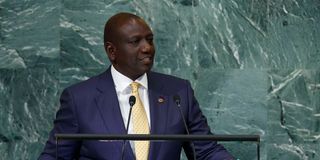Ruto’s moves on climate issues herald welcome focus

President William Ruto speaks during the 77th session of the United Nations General Assembly at the UN headquarters on September 21, 2022, in New York City.
What you need to know:
- It is heartening that the conversation on climate change seems to be taking centre stage at last.
- By establishing the Office of the Council of Climate Change Adviser, President Ruto clearly intends to pump up investments here and accelerate the pace of implementation of climate change mitigating initiatives.
- It is eminently desirable that he does so because the negative impact of climate change is at the core of national and global development challenges.
By establishing the Office of the Council of Climate Change Adviser and domiciling it within his office, President William Ruto clearly intends to pump up investments here and accelerate the pace of implementation of climate change mitigating initiatives.
It is eminently desirable that he does so because the negative impact of climate change is at the core of national and global development challenges.
An immediate powerful illustration of this challenge is the death and starvation confronting millions of Kenyans in 23 counties – most of them in arid and semi-arid regions.
Drought has decimated millions of livestock, denying the large pastoralist communities food and money that they got from selling livestock.
It is a crippling double blow whose impact is set to continue well into the medium term because there is no sign of rain anywhere on the horizon.
It has taken three seasons of inadequate rains or none at all to force these communities to their knees.
They should brace for another season of devastation and death because it will take the President and his government a lot longer than a season before their initiatives start being felt.
Women-driven agenda
In an interesting coincidence, women ministers will be driving the initiatives around climate change mitigation: Soipan Tuya (Environment and Forestry); Rebecca Miano (East African Community, Arid and Semi-Arid); and Alice Wahome (Water and Sanitation).
Ms Tuya will be leading an ambitious campaign to have Kenyans plant five billion trees by 2027 and another 10 billion by 2032.
The target is to have more than 30 per cent tree cover, which is what may give us some level of protection from the vicissitudes of climate change.
The current tree cover of 12 per cent and forest cover of just below nine per cent is not sufficient protection.
Our Cabinet Secretary must also protect the country’s five water towers: Mt Kenya, the Aberdare Range, the Mau Complex forests, the Cherangani Hills and Mt Elgon. Ongoing efforts to protect the Mau ranges must be redoubled and populist politics toned down.
We need more collaborative initiatives with communities around the other water towers to reduce or end human activity that reduces forest cover.
Hard climate knocks
Ms Miano has plenty to worry about in the arid and semi-arid lands docket. Apart from the immediate task of providing food and water to hungry and thirsty human beings and their livestock, she must think long and hard about how to improve the resilience of these communities so that they better withstand hard climatic knocks.
More dams to trap seasonal rains, more boreholes, planting more trees whenever possible, etc. It is possible, even if a bit expensive, for large portions of these lands to be greened.
For Ms Wahome, the question is how best to use the little water available to us now. Huge amounts of water are wasted during rains that now come down when least expected.
Kenyans must learn to harvest and store this water for use when rains disappear. How do water companies best serve people and reduce non-revenue water?
Water infrastructure must be rehabilitated to reduce wastage due to leakages, etc.
Beyond the three ministries, there is plenty more to be done. In agriculture, our farmers must shift to climate-resilient farming practices.
They must inter-crop, learn to use soil-enhancing fertilisers and other growth inputs, terrace farms that are on slopy terrain, etc.
They need knowledge about weather changes and their implications.
Across the country, very many farmers still wistfully wish for long-gone predictable weather patterns.
They must start paying attention to weather reports to determine when and what to plant.
Failure to appreciate this has led to a steady decrease in yields, increased food insecurity and generally entrenched poverty among the millions of small-scale farmers that drive agriculture.
Knowledge to promote climate-smart agriculture exists. But it needs to percolate to the level of individual farmers.
National efforts must of course be complemented by regional and global initiatives to control climate change and specifically reduce global warming.
November is the month of global climate conversations and Kenya will be participating fully at the COP27 taking place in the Sharm-el-Sheik resort town in Egypt.
There is not going to be much progress reported on raising the huge amount of money needed to invest in climate change impact mitigation.
This is unfortunate and Kenya’s delegation led by the President must condemn the selfishness and hypocrisy of the rich nations.
However, we condemn as we build a protective fence around ourselves by planting our trees, conserving and using the little water we have, reducing reliance on fossil fuels, improve on our agricultural practices, etc.
It is heartening that the conversation on climate change seems to be taking centre stage at last.
Mr Mshindi, a former Editor-in-Chief of Nation Media Group, is now consulting. [email protected]; @TMshindi.





